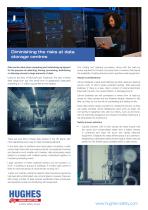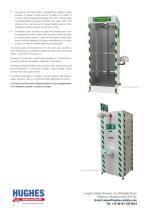 Website:
Hughes Safety Showers
Website:
Hughes Safety Showers
Group: Justrite Safety Group
Catalog excerpts

Diminishing the risks at data storage centres Data centre sites store computing and networking equipment for the purpose of collecting, storing, processing, distributing or allowing access to large amounts of data. The cooling and cleaning processes, along with the back-up power required for the sites can pose risks to workers that require the availability of safety showers and/or eye/face wash equipment. Used by the likes of Microsoft and Facebook, the size of these sites range from just one small room to gargantuan campuses stretching to 7.2 million square feet at their largest. Hazard considerations Lithium batteries or lead-acid batteries are often used as a backup source, both of which create potential hazards. With lead-acid batteries, if there is a leak, direct contact of internal electrolyte liquid with the skin can cause irritation or damaging burns. Lithium batteries are still considered a newer form of back-up power for data centres and are therefore largely untested in this field, but they do run the risk of overheating and setting on fire. Every data centre needs a system for cooling the servers, as they can easily overheat. Some refrigerants used, such as water, are not harmful if splashed onto skin but others, such as ammonia, can be extremely dangerous and require immediate flushing at a set temperature to avoid burns. Safety shower solutions • There are over 200 of these data centres in the UK alone, with more appearing every year to meet increasing demand. Cubicle showers with in-built sumps are ideal ensure that any spray and contaminated water from a safety shower is contained and does not touch any nearby electrical equipment. Designed for areas where space is at a premium, designating a dedicated safety shower space, these units are perfect for the limited space available within a data centre. In the early days of primitive room-sized giant computers, a data centre might have had one supercomputer. As equipment evolved and became much smaller and cheaper, data processing needs started to increase with multiple servers networked together to increase processing power. Large numbers of these clustered servers can be housed in a room, a building or groups of buildings. A modern data centre is likely to have thousands of small servers running 24/7. ‘Lights-out’ centres, where the need for direct access by personnel has been all but eliminated, are commonplace. However, there are still a large number of data centres worldwide where employees are frequently onsite and interfacing with equipment.
Open the catalog to page 1
Anhydrous ammonia used in refrigeration, requires safety showers to deliver a large amount of water for at least 15 minutes, at a temperature between 25C-30C. Temperature Controlled Safety Showers maintains the water within this range and can also be used to supply heated water to other emergency safety showers in the local vicinity. Emergency tank showers are often the simplest and most comprehensive way to meet ANSI standards with the ability to provide tepid water in most environments. Additionally, these units are designed for areas where there is no mains supply or where the water...
Open the catalog to page 2All Hughes Safety Showers catalogs and technical brochures
-
STD-H-25KS/P Datasheet
2 Pages
-
STD-25K(S)/P Datasheet
2 Pages
-
EXP-33G(S)/45G Datasheet
2 Pages
-
EXP-SD-20G(S)/45G Datasheet
2 Pages
-
EXP-18G(S)/45G Datasheet
2 Pages
-
EXP-AH-5G/45G Datasheet
2 Pages
-
STD-25K Datasheet
2 Pages
-
EXP-SD-18G(S)/45G Datasheet
2 Pages
-
STD-75G Product Datasheet
2 Pages
-
EXP-23G/H Product Datasheet
2 Pages
-
EXP-65GS Product Datasheet
2 Pages
-
EXP-63GS Product Datasheet
2 Pages
-
EXP-SD-65G Product Datasheet
2 Pages
-
EXP-SD-63G Product Datasheet
2 Pages
-
EXP-AH-2G Datasheet
2 Pages
-
STD-MH-15KS/11K Datasheet
2 Pages
-
EXP-18G Datasheet
2 Pages
-
EXP-23G/OD EXP-23GS/OD
2 Pages
-
EXP-23G/V Product Datasheet
2 Pages
-
EXP-23G Product Datasheet
2 Pages
-
EXP-SD-18G Product Datasheet
2 Pages
-
EXP-AH-5G Datasheet
2 Pages
-
STD-MH-5KS/11KS Datasheet
2 Pages
-
STD-TC-100KS/45G Datasheet
2 Pages
-
Hughes Safety Showers Brochure
32 Pages
-
STD-68G Product Datasheet
2 Pages
-
EXP-J-14KS/1500 Datasheet
2 Pages
-
EXP-J-14KS/350 Datasheet
2 Pages
-
EXP-MH-14K/350 Datasheet
2 Pages
-
EXP-MH-14KS/1500 Datasheet
2 Pages
-
EXP-MH-14KS/1500-P Datasheet
2 Pages
-
EXP-EJ-45GS/P Datasheet
2 Pages
-
EXP-AH-45G/P Datasheet
2 Pages
-
EXP-EJ-5G/45G Datasheet
2 Pages
-
EXP-EJ-5G/10G Datasheet
2 Pages
-
EXP-EJ-5GS Datasheet
2 Pages
-
EXP-AH-5G/10G Datasheet
2 Pages
-
EXP-AH-2G Datasheet
2 Pages
-
GRP-RAMP Datasheet
1 Pages
-
GRP-BARRIER Datasheet
1 Pages
-
TEST-KIT Datasheet
1 Pages
-
GRP-H-CAB Datasheet
2 Pages
-
HOSE-REEL Datasheet
2 Pages
-
HR-CABINET Datasheet
2 Pages
-
STD-45G Product Datasheet
2 Pages
-
STD-45G/P Product Datasheet
2 Pages
-
STD-75G/P Product Datasheet
2 Pages
-
STD-85G Product Datasheet
2 Pages
-
STD-85G/P Product Datasheet
2 Pages
-
LAB-85GS Product Datasheet
2 Pages
-
LAB-85GS/T Product Datasheet
2 Pages
-
LAB-85GS/P Product Datasheet
2 Pages
-
EXP-20G Product Datasheet
2 Pages
-
LAB-23GS/H Product Datasheet
2 Pages
-
LAB-23GS Product Datasheet
2 Pages
-
LAB-23GS/V Product Datasheet
2 Pages
-
STD-SD-31K Product Datasheet
2 Pages
-
EXP-SD-20G Product Datasheet
2 Pages
-
STD-28G
2 Pages
-
STD-58G
2 Pages
-
STD-75GS/P Datasheet
2 Pages
-
Optiflex Product Datasheet
2 Pages
-
STD-38G
2 Pages
-
Hughes Zero Power Cooler®
2 Pages
-
STD-J-40K/45G
2 Pages
-
Optiflex 500 / Optiflex 600
2 Pages
-
GRP Ladder Platform
1 Pages
-
Alarms
1 Pages
-
STD-25K , STD-25KS
2 Pages
-
LAB-23GS/OD
2 Pages
-
Optiflex 100,Optiflex 200
2 Pages
-
STD-25K/P
2 Pages
-
EXP-SD-75G/P
2 Pages
-
MPC-H-2GS/11KS
2 Pages
-
STD-45G
2 Pages

















































































































